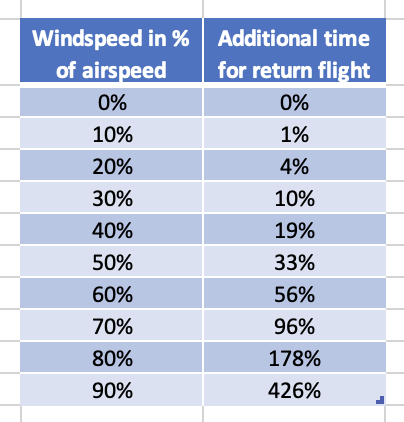In the planning of this trip (which in CV19 times is best done without a fuel stop) I looked at the effect of a given wind on how long it takes to fly a specific distance.
As expected, any wind is a negative factor, because headwind costs you more than tailwind, but if you fly the same route there and back, the effect is pretty well negligible unless you see more than say 20kt.
Number of hours to fly a 1000nm distance, there and back, versus the head/tailwind (x axis) and for different values of TAS

Peter wrote:
the effect is pretty well negligible unless you see more than say 20kt.
Depends on how fast you fly.
Bringing that into a different form, it is always surprising how low the impact of wind is for a return flight as long as windspeed is in the range of normal windspeed in Europe:

I did a calculation for different things but notably for 140kt TAS which is fairly typical for the TB20 best-MPG high altitude engine settings.

I had the leave out the case of 100kt TAS and 100kt wind 
As regards “normal” windspeeds, this is where the problem lies. One can easily see 50kt at altitude.
The surprising thing is the extent to which headwind and tailwind even out. Intuitively this is to be expected, of course (calculus of small changes). The gotcha is that the wind is nearly always stronger than forecast…
Peter, could you elaborate on that table? I can’t make any sense of it.
Rows indicate headwind component, but what do the columns do? Time to what? Endurance is independent of wind, should be the same at each TAS.
Ah ok I get it. Time in hours to fly 1000 NM.
Yes, sorry. Time in hours to fly 500nm there and 500nm back in the same wind.
I will try to do another spreadsheet showing how much effect a 90 degree wind (crosswind) has. It is not immediately obvious whether it is more, or less, than a constant headwind/tailwind of the same magnitude. I did a quick calculation at 140kt TAS and while a 20kt head/tailwind costs you 2%, a 20kt crosswind costs you 1%, which surprises me.
Hi
I attempted to calculate the effect of side wind on ground speed on a one-way trip, for various wind azimuths.
Here’s the result, given as the difference between TAS and GS, for TAS = 120kt and different wind velocities. The wind azimuth is defined as:
- 0°: “pure” headwind
- 90°: crosswind
- 180°: “pure” tailwind
The “neutral” azimuth (i.e. GS=TAS) increases with wind velocity. It is somewhere between 90+° and 105° for wind velocities between 10kt and 60kt.
Any comments welcome.

Yes this shows nicely that headwind costs you more than tailwind gets you back.
The relationship against wind speeds is quite amazing.
Your spreadsheet skills are way better than mine 
Costs more than you get back? Only inbetween full HW vs. full TW, right?
A 60kts full HW or TW gives exactly – or + 60kts TAS.
Or do I miss something?
Snoopy wrote:
A 60kts full HW or TW gives exactly – or + 60kts TAS.
Yes, but for any non-zero choice of X, flying X nmi with -60 kts TAS will make you “loose” more time than the time “won” by flying X nmi with +60 kts TAS.